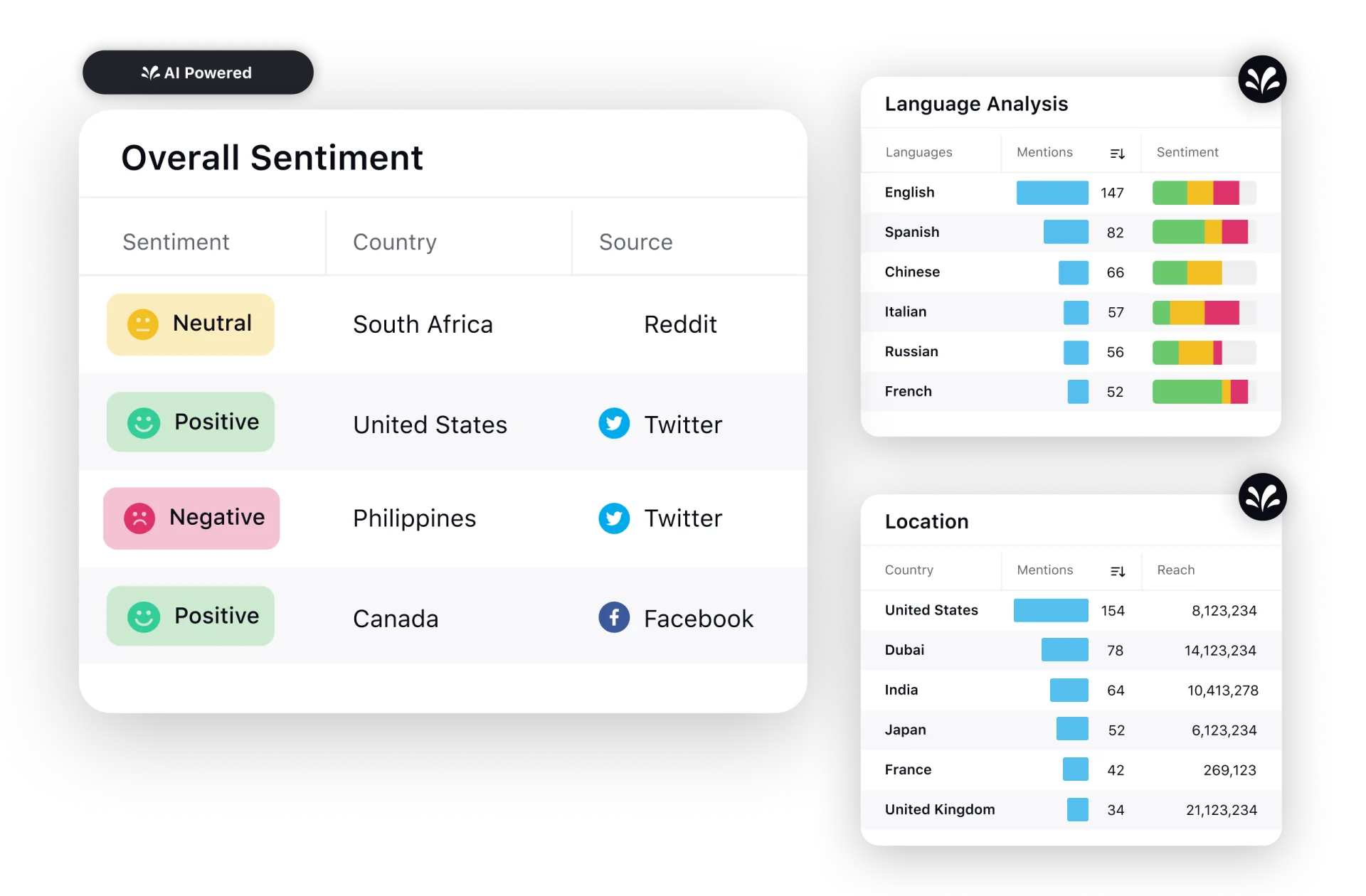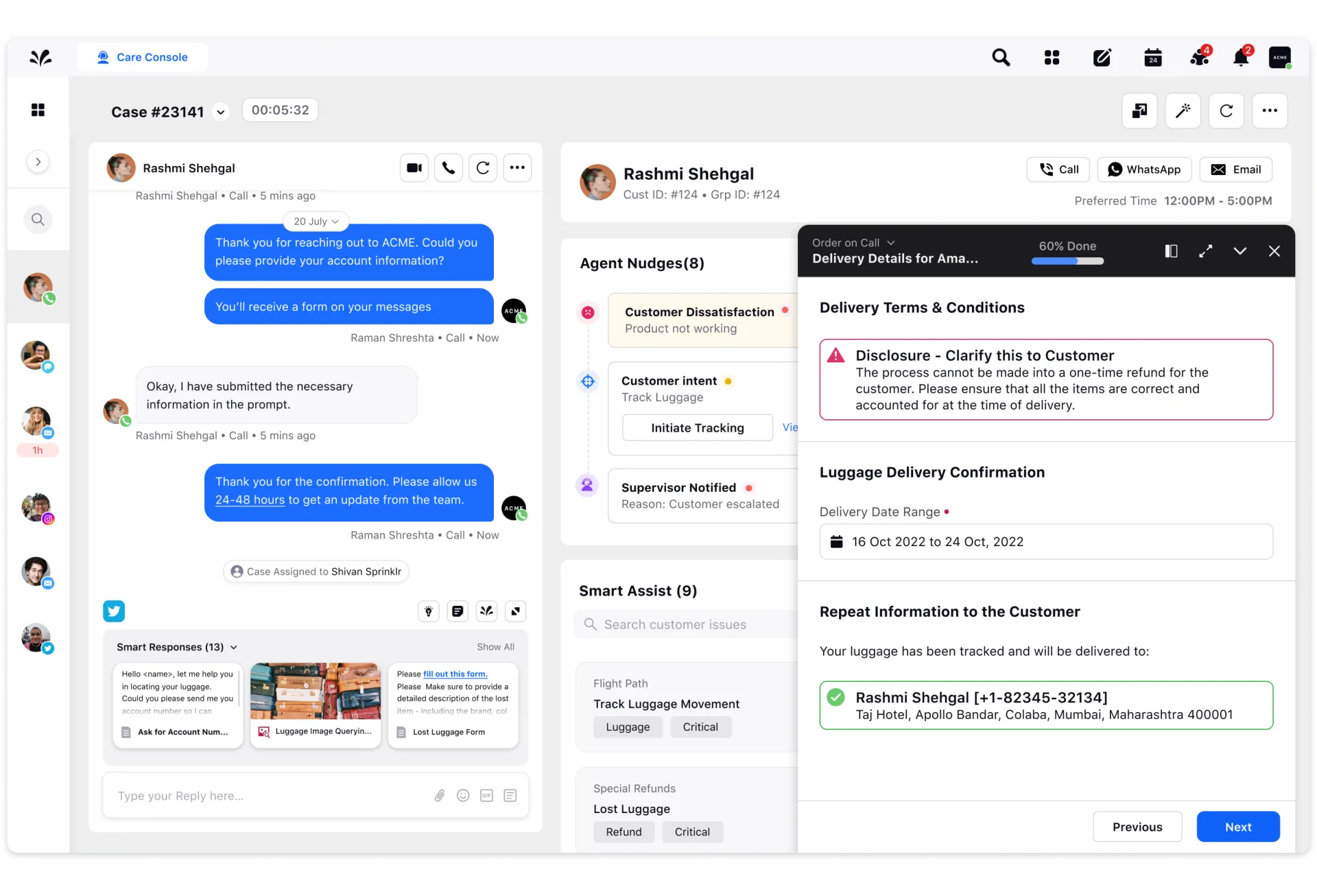- What is call listening?
- Why is call listening important?
- Difference between call listening and call monitoring
- Setting up call listening: A step-by-step approach
- Strategies and quick tips for effective call listening
- Six proven techniques for effective call listening
- Time to transform call listening with Sprinklr AI+
What is call listening?
Call listening, a strategic practice in customer-centric operations, involves the deliberate and unobtrusive monitoring of live or recorded calls, typically within call centers or contact centers. It is a pivotal practice for evaluating the quality of customer interactions, akin to discreetly sitting in on a conversation without active participation.
Call listening enables you to comprehensively assess the performance of customer service representatives, pinpoint areas for training and development and ensure unwavering compliance with service standards.
By actively engaging in call listening, you can improve customer service, elevate customer satisfaction, optimize operational processes and contribute to overarching objectives such as revenue growth and sustainable success.
Why is call listening important?
Call listening offers insights into customer concerns, queries and overall customer service. This feedback is crucial for tailoring products and services more closely to customer needs, improving customer satisfaction and loyalty.
Here is how call listening helps:
Quality assurance and compliance: Ensuring customer service representatives adhere to predefined service standards is paramount. Call listening provides a call center quality assurance mechanism, allowing you to evaluate interactions against established benchmarks. This safeguards the integrity of customer interactions and ensures contact center compliance with industry regulations and internal policies.
Deep dive: What Is Call Center Quality ManagementInsights into customer expectations: Ever wish you could read minds? Well, call listening lets you eavesdrop on customer conversations, picking up on their expectations, frustrations and what makes them happy.
Performance evaluation and training needs: Call listening enables you to assess the strengths and weaknesses of individual representatives, identify areas for improvement and tailor training programs to address specific needs. It's a proactive approach to fostering continuous professional development.
Suggested read: Using AI Scoring in Contact Centers to Tailor Agent Training ProgramsEnhancing customer satisfaction: The ability to swiftly and adeptly address customer concerns directly correlates with heightened customer satisfaction. Call listening facilitates the identification of pain points in customer interactions, allowing you to implement targeted improvements. As a result, customer service becomes not just a transactional process but a strategic avenue for building long-term customer loyalty.
Building consistency across interactions: Consistency is key in customer service. Call listening ensures that service delivery remains uniform across various representatives and over time. This consistency is foundational for building a cohesive brand image and fostering customer trust.
Strategic decision-making: The more information you have, the better your decisions will be. Call listening provides a nuanced understanding of market trends, customer preferences and areas of operational strength or weakness. With this knowledge, organizations can make informed decisions on product strategy and stay ahead in a competitive landscape.
Difference between call listening and call monitoring
Aspect | Call listening | Call monitoring |
Definition | The practice of passively listening to live or recorded calls to assess the quality of customer interactions | The systematic review and analysis of live or recorded calls for various purposes, including quality assurance, performance evaluation and compliance |
Level of Engagement | Passive observation without active participation in the conversation | Active involvement, allowing the supervisor to intervene, provide guidance or take over the call if necessary |
Purpose | Primarily focused on evaluating the customer service representative's performance and identifying areas for improvement | Multifaceted, including quality assurance, training, compliance verification and escalation management |
Focus on Representative | Emphasizes the performance and skills of the customer service representative | Broader focus on overall call quality, compliance and immediate issue resolution |
Intervention | Limited intervention, typically for training purposes or after-call customer survey for feedback | Active intervention is possible, allowing the monitor to guide the representative during the call or take control if needed |
Role in Training | Primarily used for identifying training needs and improving call center agent skills | Supports training but also facilitates on-the-job learning through real-time guidance and feedback |
Setting up call listening: A step-by-step approach
Call listening substantially benefits call center performance, enhancing customer interaction and team efficiency. However, its implementation presents challenges that must be carefully navigated. To effectively integrate call listening, it's essential to adhere to data privacy regulations and obtain customer consent where necessary.
Additionally, addressing any discomfort or perception of call listening as punitive among agents is crucial. Clear communication about the purpose of call listening, emphasizing its role in boosting performance and customer satisfaction, is critical. This approach ensures a positive and productive environment for your team and customers.
Here are the steps to effectively set up call listening in your organization:
Step 1: Establish objectives
Before diving into the technical aspects, articulate the overarching goals of your call listening initiative. Whether it's improving customer satisfaction, enhancing representative performance or ensuring regulatory compliance, clarity on objectives sets the foundation. Identify call center key performance indicators (KPIs) that align with these goals, such as first-call resolution rates or customer satisfaction scores.
Step 2: Invest in the right technology
Look for solutions that offer both live and recorded call monitoring capabilities. Consider features like speech analytics, sentiment analysis and integration capabilities with your existing contact center CRM. The goal is to invest in a solution that aligns with your organization's specific needs and goals.
Find the full list of call center technologies here.
Step 3: Train your team
Prepare your customer service representatives for the integration of call listening by developing comprehensive training programs. Emphasize the positive aspects of call listening, highlighting how it serves as a tool for professional growth and contributes to the team's overall success. Guide how representatives can use feedback from call listening sessions to enhance their skills.
Deep dive: Call Center Agent Training - A Detailed Guide
Step 4: Implement a calibration process
This involves regular meetings where your call listening team discusses and aligns on their evaluations. Calibration ensures that different evaluators apply standards consistently, reducing bias and enhancing the reliability of your assessments.
Step 5: Ensure compliance with regulations
Given the sensitivity of customer interactions, work closely with legal and compliance teams to establish and adhere to guidelines that protect customer privacy and your organization's legal standing.
Step 6: Monitor and iterate
Regularly monitor the effectiveness of your call listening program through ongoing analysis of key customer service metrics and feedback. Use this information to iterate on your training programs, quality assurance standards and technology solutions to adapt to changing business needs and customer expectations.
Strategies and quick tips for effective call listening
🔍Focus on high-value interactions | ❗Set up alerts for keywords |
👥Peer reviews | 📊 Scorecards for evaluation |
Six proven techniques for effective call listening
You've established call listening, accumulating a wealth of valuable data. Yet, the true potential unfolds when you elevate your strategy with specialized techniques. Let's move beyond the basics and delve into methods that will amplify the impact of your existing call-listening practice.
Technique 1: Use emotional intelligence
Using emotional intelligence in call listening is about more than just picking up on the customer's feelings. It's about going deeper and understanding why they feel the way they do. By doing so, you can tailor your responses and solutions to be more empathetic and effective, turning every customer interaction into an opportunity for building customer loyalty.
Quick tips to make the most of this technique:
Utilize speech analytics
Develop an emotional lexicon for your team
Utilize AI for real-time sentiment analysis in customer conversations.
AI advantage: Leveraging analytics and reporting software enables you to discern not only the tone but also the buyer's intent, sentiments, pain points and areas of friction during real-time calls. This heightened awareness empowers you to engage in more empathetic and personalized interactions, ultimately contributing to an enhanced customer experience.

Editor’s Pick: How Understanding the Science of Emotions Can Make You Better at Customer Experience
Technique 2: Cross-functional collaboration
Cross-functional collaboration isn’t just about a one-off meeting between departments. It's about creating a sustained, cohesive strategy that aligns with everyone's objectives. By bringing varied departmental insights into the call-listening process, you unlock a holistic view of customer interactions that individual teams might miss.
Quick tips to make the most of this technique:
Create cross-departmental teams for listening sessions
Share summaries across departments
Develop KPIs that reflect multi-departmental benefits
AI advantage: Harnessing a consolidated AI layer, Sprinklr AI+ ensures that insights garnered by one team can seamlessly influence actions in another. For example, the customer service team's insights can directly drive product enhancements or inform the creation of impactful marketing campaigns. This integrated approach empowers your teams to collaborate effectively and enhance brand cohesion.
Technique 3: Context-specific annotations
Annotations add value to your call-listening efforts by helping you mark key moments during customer interactions. This is not just about flagging keywords but capturing the nuance of how something is said. These context-rich annotations serve as a roadmap for future interactions, enabling your team to deliver more personalized and effective service.
Quick tips to make the most of this technique:
Make annotation guidelines
Review annotations during team briefings
Also read: Introduction to Customer Interaction Analytics
Technique 4: Competitor mentions
When a customer mentions a competitor, it's not necessarily bad. It can provide valuable insights into how your market perceives you relative to others. Moreover, these mentions can highlight gaps in your service or offerings, giving you actionable conversational intelligence to gain a competitive edge. This helps you to realign your strategies effectively.
Quick tips to make the most of this technique:
Automate the tracking of competitor mentions
Discuss competitor mentions in strategy meetings
Use the data for focused strategic competitive analysis
Technique 5: Customer journey mapping
Customer journey mapping informed by call listening offers a 360-degree view of your customer interactions. It's not a static document but a living guide that evolves based on real-world data. Incorporating the insights from call listening into your map allows you to identify pain points and opportunities with greater precision, enhancing customer retention and satisfaction.
Quick tips to make the most of this technique:
Integrate call listening insights into your customer journey map
Use the map for onboarding new team members
Update the map quarterly based on call listening insights
Technique 6: Real-time decision support
Real-time analytics during call listening serve as a decision support tool. They empower your agents to take the most effective action while conversing with customers. This dynamic approach allows for quick problem-solving and fosters a proactive customer service environment, reducing the likelihood of customer frustration and improving overall satisfaction.
Quick tips to make the most of this technique:
Develop quick reference sheets for agents
Monitor the impact of real-time decisions on customer satisfaction
Good to know: Modern agent assist software can accelerate the resolution of customer queries by 50%, leveraging real-time nudges, contextual recommendations and smart responses generated by AI.

Time to transform call listening with Sprinklr AI+
As you immerse yourself in the intricacies of call listening, a prominent challenge surfaces: the potential inundation of data.
While the insights derived from call listening are invaluable, the sheer volume of information can be overwhelming without a strategic approach. Handling this wealth of data efficiently necessitates the right technology and a meticulously crafted strategy aligning with organizational objectives.
Using the industry's most reliable and responsible AI engine, Sprinklr AI+ comprehensively analyzes all interactions across 30+ digital channels. The platform helps you optimize agent performance, identify new revenue and coaching opportunities, and enhance quality assurance and compliance standards. Here’s how:
Real-time insights and timeline views: Obtain a comprehensive overview of both voice and non-voice cases in real time, enabling swift and informed decision-making.
AI-powered agent insights: Leverage AI to aggregate and analyze agent performance at a macro level. This empowers you to provide targeted coaching and optimize resource allocation for enhanced efficiency.
Case analytics views: Access detailed case analytics to analyze trends and identify gaps, facilitating data-driven decision-making.
SLA tracking: Monitor SLAs and escalations in real-time, enabling proactive intervention and resolution for a seamless customer experience.
To learn more, Schedule a demo with our experts today and explore how Sprinklr Service can help you.
Frequently Asked Questions
related products
Thank you for contacting us.
A Sprinklr representative will be in touch with you shortly.
Contact us today, and we'll create a customized proposal that addresses your unique business needs.
Request a Demo
Welcome Back,
No need to fill out any forms — you're all set.



